Group | Statistics in Epidemiology
The Statistics in Epidemiology group focuses on the design and analysis of a wide range of studies in epidemiology including observational studies and trials.
The group operates the data centre of the Swiss Cohort Study on Air Pollution and Lung and Heart Diseases in Adults (SAPALDIA) and more recently for the COVCO-Basel study. We develop models for studying the long- and short-term effects of environmental exposures on population health and support analyses of these cohorts collaborating internationally.
We collaborate with and provide statistical support to researchers. We have particular interests in the analysis of cohorts, and in applications in non-communicable disease and infectious diseases such as malaria.
The group runs statistics courses in the Faculty of Science and contributes to postgraduate courses in the medical curriculum.

Amanda Ross
PD, PhD
Group Leader
+41612848110
amanda.ross@swisstph.ch
Key Projects

SAPALDIA: Swiss Cohort Study on Air Pollution and Lung and Heart Diseases in Adults
The SAPALDIA cohort investigates since 1991 the effects of life style and environment on the chronic diseases and aging in adults of the Swiss general population. To investigate causal biologic mechanisms a systematic prospective collection of population-based blood samples was started and the SAPALDIA biobank was established. SAPALDIA is one of the very few population-based adult longitudinal cohort studies in Europe examining the exposome of cardio-respiratory disease, multi-morbidity, and also healthy aging. Read more

Exposome Powered Tools for Healthy Living in Urban Settings
By studying the impact of the Urban Exposome on the major contributors to Europe’s burden of disease: Cardio-Metabolic and Pulmonary Disease, the EXPANSE project will address one of the most pertinent questions for urban planners, policy makers, and European citizens: “How to maximize one’s health in a modern urban environment?” Read more

Visual Analysis of Long Lasting Insecticidal Nets to Maximise Universal Access
Long-lasting insecticidal nets (LLINs), or bed nets, are the mainstay of malaria control. However, more than 50% of people living in endemic areas are currently unprotected because LLINs often wear out sooner than their expected lifespan. The goal of the ViALLIN MUsAcc project is to develop a digital tool enabling national malaria control programmes to improve planning for programmatic LLIN distribution, monitoring of LLIN quality and selection of the best product for use according to contextual settings. Read more
Selected Projects
All ProjectsLatest Publications
All PublicationsDalecká A et al. Air pollution, greenspace, and metabolic syndrome in older Czech and Swiss populations. Environ Epidemiol. 2025;9(3):e393. DOI: 10.1097/ee9.0000000000000393
Mbuba E et al. Estimating the hole surface area of insecticide-treated nets using image analysis, manual hole counting and exact hole measurements. Malar J. 2025;24:82. DOI: 10.1186/s12936-025-05324-7
Minconetti V et al. Health system effectiveness of symptomatic malaria case management in Papua New Guinea. BMJ Glob Health. 2025;10(3):e016825. DOI: 10.1136/bmjgh-2024-016825
Fairbanks E.L et al. Inference for entomological semi-field experiments: fitting a mathematical model assessing personal and community protection of vector-control interventions. Comput Biol Med. 2024;168:107716. DOI: 10.1016/j.compbiomed.2023.107716
Hiza H et al. Bacterial diversity dominates variable macrophage responses of tuberculosis patients in Tanzania. Sci Rep. 2024;14:9287. DOI: 10.1038/s41598-024-60001-0

 Marc Grünig
Marc Grünig
 Dirk Keidel
Dirk Keidel
 Amanda Ross
Amanda Ross
 Emmanuel Schaffner
Emmanuel Schaffner
 Christian Schindler
Christian Schindler